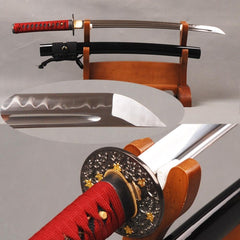The Companion Sword - The Wakizashi
3 minute read
Called to the Castle
Akihiko was nervous. He had just been called by his daimyō (feudal lord). The crescent moon was intermittently obscured by wispy clouds blown by unfelt winds. As he made his way along the well-worn road marked by the seasonal passage of traders, he could occasionally hear the lapping of the water on the shores of the dark river to his left, cold and swift as it ran from its source in the cold mountains behind him toward its final destination, the endless waiting expanse of the ocean. As he neared the castle, he could see see a few windows shining with the soft radiance of candlelight and the occasional snatch of a conversation drifting along with the wind. Walking up the incline to the nearest gate in the imposing wall, easily twice his height, he was noticed by the guards.
“Stop right there and state your business”, they challenged him. “My name is Akihiko, and I’ve been summed by my lord.” he replied as calmly as he could manage. “Ah, yes, the Samurai. We’ve been expecting you. You know the drill”. Akihiko took off his Katana and gave it to the guards, feeling somewhat naked with only his Wakishazhi remaining as he stepped past the guards and entered the castle.
Featured Sword: Wakizashi
The Wakizashi was a shortsword typically carried with a Katana by Samurai as part of a daishō (set of two swords: one long, one short). It served multiple purposes including serving as a temporary replacement for the Katana in case of breakage, beheading opponents, and allowing ritual suicide. Unlike Katanas, Wakizashi could be worn indoors when entering a palace or castle. It could also be used for combat when paired with a Katana in the Two Heavens technique. A Wakishaszi is 1-2 shaku in length (30.3cm to 60.6cm) and worn on the left side of the bearer.
Featured Examples
The Path Ahead
Akihiko followed a servant through several hallways until he arrived at an ornate double-door. After the servant announced him and he was permitted to enter, he saw the daimyō for the first time. The man was of middling height with an air of command. “Do you know why I summoned you here?” the lord asked. “No sir”, Akihiko replied. “I have a special mission for you” the head of the castle stated ominously. “It is very dangerous, and you may not return...”
As Akihiko retraced his steps back to the gate, he noticed the elegant wood trimmings of the walls and the exquisite craftsmanship of the stone foundation. With his path now laid out for him, he knew it would likely be many more months before he would again see anything more refined than a sleeping role under the stars or the saddle on a horse’s back. When he reached the guards, he silently held out his hand and they returned his Katana to him. Feeling whole again, with the comfortable weights of both his Katana and Wakizashi on his obi, he began the walk back to his quarters to begin packing what few things he had for the long journey ahead.
Fun Fact
Wakizashi are not just shorter Katanas, but may be forged differently and are less convex.
Etymology
The Wakizashi is represented by the characters 脇差 in Japanese. 脇 means “side of the torso” and 差 means “to insert, stick into”, which combined represent how the Wakizashi would be worn by the bearer.

 Iato Clay Tempered Carbon Steel Wakizashi
Iato Clay Tempered Carbon Steel Wakizashi Abriana Wakizashi Samurai Sword
Abriana Wakizashi Samurai Sword Aiya Wakizashi Samurai Sword
Aiya Wakizashi Samurai Sword